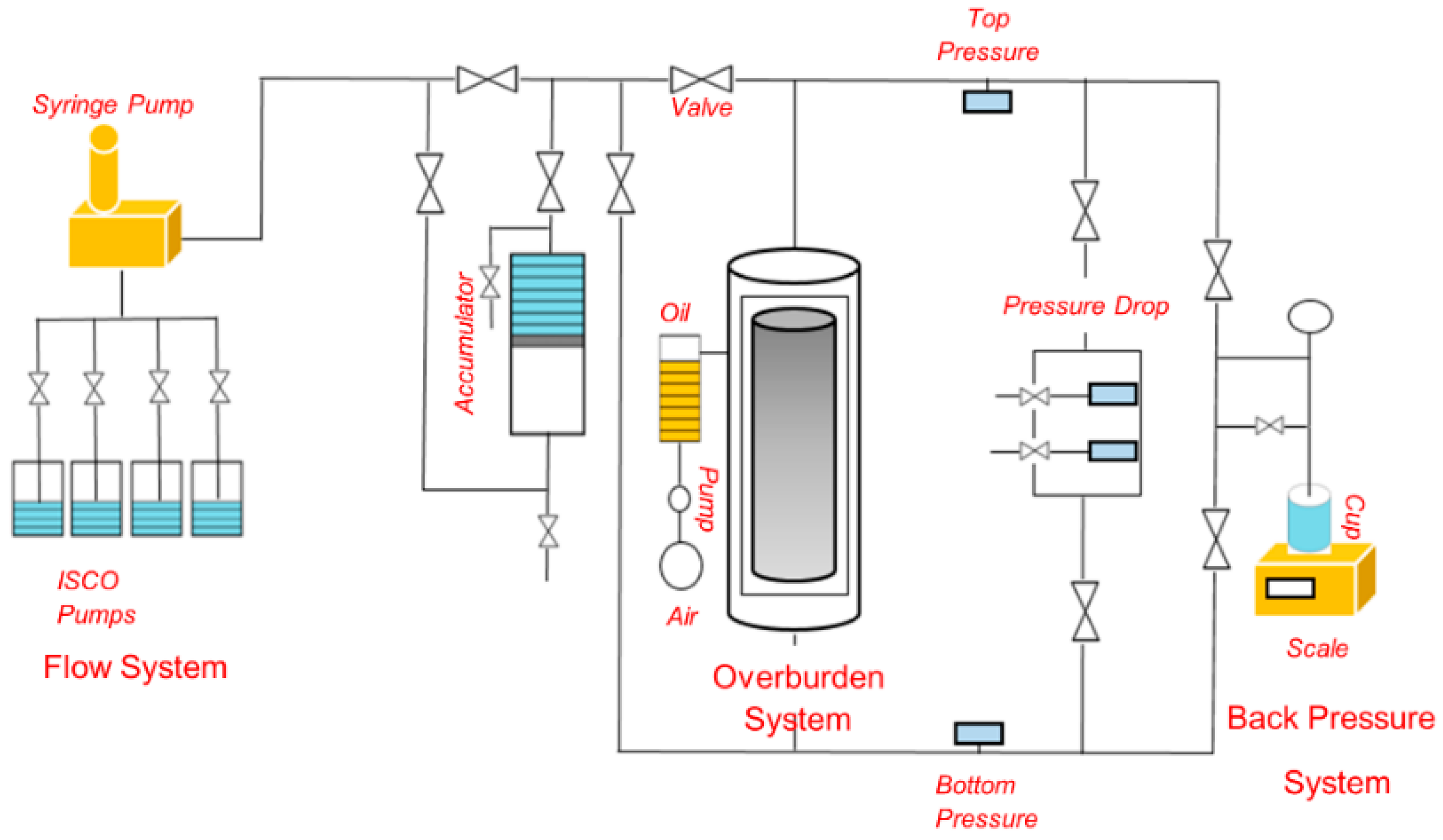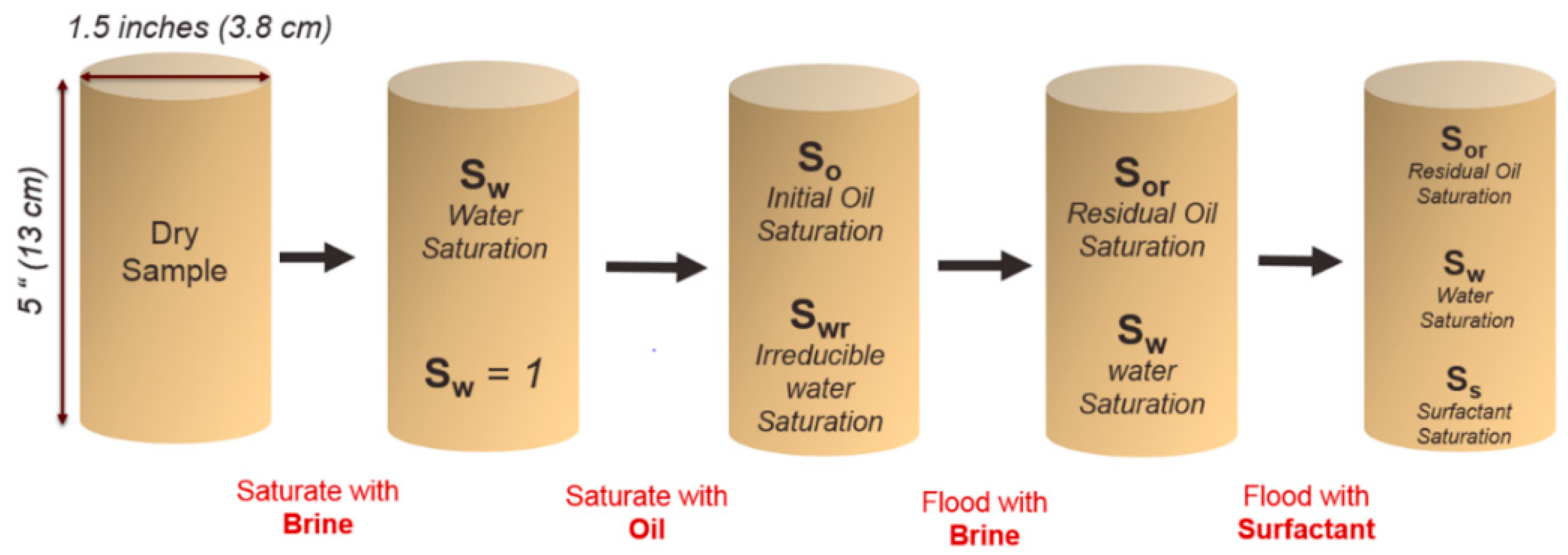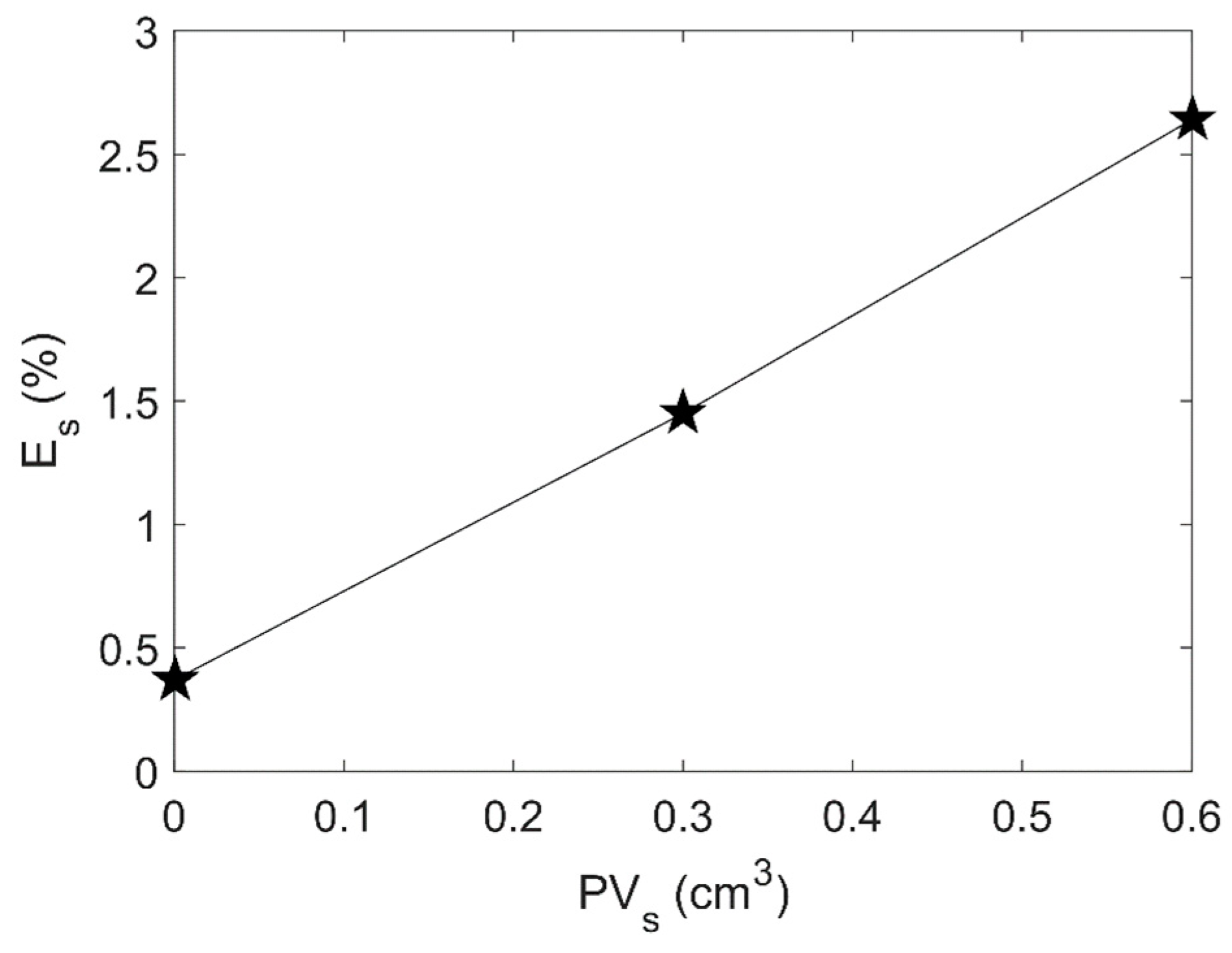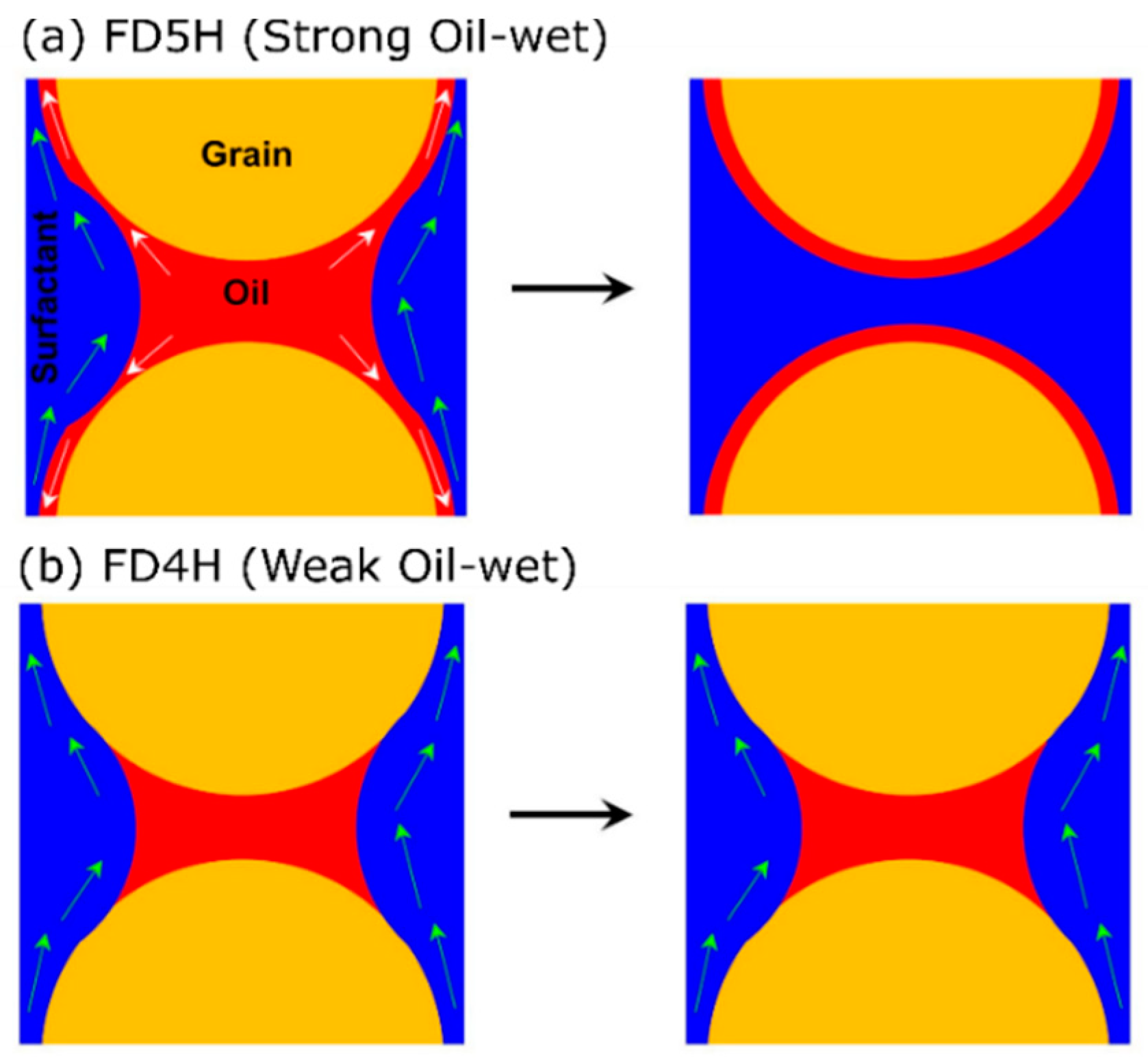1. Introduction
With increasing demand for energy globally remaining largely unperturbed, the development of effective and economic enhanced oil recovery (EOR) techniques may prove to be a critical component in meeting future energy requirements. Forming a suite of processes targeted at reducing oil saturation within a reservoir below its intrinsic residual oil saturation (S
or), EOR techniques seek to displace greater volumes of trapped oil from within a given reservoir rock that are not readily mobilized by waterflooding alone [
1]. Historically, carbonate reservoirs have formed an important focus for the deployment of EOR techniques. Constituting over half of the world’s conventional oil reserves, carbonate reservoir settings are commonly characterized by poor recovery efficiency compared to conventional clastic plays [
2]. The restricted producibility of many carbonate reservoirs is often due to the presence of highly heterogeneous pore networks therein. Multifarious burial and fluid charge histories, coupled with the innate chemical susceptibility of carbonate rock forming minerals (especially calcite) can often result in a high degree of pore-scale complexity in such settings, in terms of pore size distribution, pore geometry and pore wall wettability [
3].
Indeed, one of the key challenges associated with carbonate reservoirs is their oil-wet nature. Owing to the surface charge that is favorable for the adsorption of polar compounds, many carbonate reservoirs exhibit oil-wet or mixed-wet tendencies [
4,
5,
6]. Oil-wet conditions are highly problematic for the efficiency of conventional flooding techniques, such as gas flooding and water flooding [
7,
8]. As the fluid is injected into the reservoir, it moves preferentially through the path of the least capillary resistance, bypassing the oil phase and subsequently leaving it trapped in the reservoir. This behavior is attributable to the strong affinity of aged calcite pore walls within many carbonate hydrocarbon reservoirs, hence resulting in earlier water breakthrough and high water-oil ratios in comparison to equivalent clastic reservoirs (i.e., sandstones) [
9].
It is widely recognized that surfactants can greatly alter fluid interfacial properties within a porous media, modifying the interfacial tension, hence reducing the strength of capillary forces [
10,
11,
12]. Belhaj [
13] demonstrated the control of the partitioning coefficient of a surfactant (the measure of the solubility of a surfactant at the fluid–fluid interface) on modifying surface forces at the fluid–fluid interface and the solid–fluid interface. They showed that an increase in partition coefficient results in a decrease in interfacial tension; moreover, it was concluded from their experimental results that the partition coefficient is directly related to the temperature and concentration of surfactant. Furthermore, Druetta and Picchioni [
14] highlighted the impact of salinity of brine on the partition coefficient, concluding that for surfactant flooding EOR operation it is important to take account of the salinity of brine. As a consequence of the significant effect of surfactants on altering the interfacial properties, in many previous studies, surfactant flooding has been employed as an EOR technique for carbonate reservoirs [
15,
16,
17]. Jarrahian et al. [
18] performed a fundamental investigation to evaluate the surfactant induced wettability alteration in carbonate rocks. Their analytical results indicate that depending on the ionic structure, the surfactant will interact differently with carbonate surface. In comparison to the anionic surfactant the cationic surfactant has a more profound impact in altering the wettability of carbonate rocks from oil-wet to water-wet. Ahmadi and Shadizadeh [
19] evaluated the impact of salt concentration on the adsorption of surfactant, called Zyziphus Spina Christi (ZSC) on the carbonate surface. In addition, they also delineated the effect of surfactant concentration on oil relative permeability and consequently on the efficiency oil recovery via core flooding experiments. Their results showed the promising effect of ZSC in improving oil recovery from carbonate core samples. In addition, it was shown that salinity has a detrimental impact on surfactant flooding as an increase in salinity of brine can lead to enhanced adsorption of surfactant on the carbonate surface.
In this research, we investigate the effect of the apparent wettability of tight carbonate rock on the efficiency of surfactant flooding at a fundamental level. It is important to note that in addition to surface wetting characteristics, the apparent wettability is also a function of pore geometry and surface roughness. We performed core-scale flooding experiments on low permeability (0.7–2.2 mD) Indiana Limestone core plug samples FD3H, FD4H and FD5H. The core samples displayed significantly different wetting characteristics, with FD3H being moderately oil-wet, FD4H showing weakly oil-wet characteristics and FD5H exhibiting strongly oil-wet characteristics. Our experimental results demonstrate that the efficiency of surfactant flooding is directly related to the apparent wettability of tight carbonate rocks. In summary, stronger affinity between the pore wall and oil phase results in higher recovery of hydrocarbons during surfactant flooding. In order to rationalize this intriguing behavior, we have presented a hypothesized pore-scale model that correlates Darcy scale observations with the pore-scale physics of the multiphase flow.
2. Experimental Procedure
The core flooding experiments were conducted using the Grace Instruments M9300 core flooding apparatus (
Figure 1), with Indiana Limestone core samples with a diameter 3.8 cm and a length of 13 cm. Three samples of Indiana Limestone were utilized in these experiments, which are referred to as FD3H, FD4H and FD5H. The properties of core samples are given in
Table 1. As seen in
Table 1 the core samples can be regarded as tight (i.e., low permeability) carbonate rocks, as their permeability ranges from 0.7 mD to 2.2 mD.
Initially the core samples were saturated with brine, and later decane was injected at 2 cc/min to about 5 or 6 pore volumes (PV), to ensure that the irreducible water saturation (Swr) was reached. After decane saturation, the core samples containing brine and decane were ready for waterflooding experiments. During water flooding, brine was injected at a flowrate of 1 cc/min for about 6 to 7 pore volumes to ensure that the residual oil saturation (Sor) was achieved. During each flooding experiment, the pressure drop across the sample was continuously monitored using paired pressure transducers.
Following the waterflooding procedure, the cores (still containing brine and decane) were prepared for surfactant flooding. The surfactant Platinum Foam Plus supplied by MI SWACO, Houston Texas, was used to perform surfactant flooding experiments. First, the surfactant mixture was prepared in the ratio of 1000 mL of water to 1 mL of liquid surfactant. The components were mixed together using a magnetic stirrer, yielding an overall concentration of 0.10 vol.%. Surfactant was injected at a flowrate of around 1 cc/min for about 7 to 8 pore volumes. Similar to decane and water flooding experiments, the pressure drop across the sample was monitored during surfactant flooding.
Figure 2 provides a summary of the experimental protocol.
3. Results and Discussion
3.1. Wettability Characterization
The pressure values recorded during decane flooding and water flooding can be seen in
Figure 3.
As demonstrated by
Figure 3, for all three core samples, pressure readings were lower during decane flooding than in the case of water flooding, indicating that it is relatively easier (lower displacement energy required) for the oil phase to enter and displace water from the pores than vice versa. Thus,
Figure 3 indicates that all three core samples exhibited oil-wet characteristics.
Spontaneous imbibition (
) is one of the key characteristics of multiphase flow in porous media that can aid us in distinguishing the degree of oil-wetness of core samples [
20]. From
Figure 3 it is clear that approximately 0.3 PV of the oil phase was spontaneously imbibed in FD3H, while in the case of FD5H, 0.6 PV was spontaneously imbibed. There was no appreciable spontaneous imbibition observed in core sample FD4H. On the basis of the quantities of oil spontaneously imbibed, it can be qualitatively deduced that FD3H, FD4H and FD5H manifest moderately oil-wet, weakly oil-wet and strongly oil-wet characteristics respectively.
3.2. Surfactant Flooding
Table 2 shows the percentage of total oil recovery during water flooding (
and surfactant flooding (
), and the efficiency of surfactant flooding (
). The efficiency of surfactant flooding was computed as
.
From
Table 2 it is evident that surfactant flooding has the capacity to improve oil recovery in tight carbonate rocks. It is important to note that the low percentages of efficiency of surfactant flooding in
Table 2 can be ascribed to the relatively low concentrations of surfactant used for these experiments, as well as the low permeability of core samples. FD5H (strongly oil-wet) exhibits the highest efficiency of 2.64%, while FD4H (weakly oil-wet) shows the lowest improvement in surfactant induced oil recovery (0.37%). The comparison of measured pressure drop results during water flooding and surfactant flooding is shown in
Figure 4.
As seen in
Figure 4, during surfactant flooding, in the cases of FD3H (moderately oil-wet) and FD5H (strongly oil-wet), after approximately injecting 2 PV the surfactant flood pressure exceeds the pressures previously achieved during water flood. However, for FD4H, surfactant and water flooding results in relatively consistent pressure values after injecting 2 PV of surfactant solution. This signifies that during flooding tests in FD3H (moderately oil-wet) and FD5H (strongly oil-wet), surfactants are able to alter interfacial tension, and therefore, weaken capillary forces (i.e., the forces responsible for the trapping of oil phase), as a consequence allowing the hydrocarbons to dislocate from the smaller pore channel as the surfactant flooding pressure becomes greater than water flooding pressure. However, in the case of FD4H (weakly oil-wet), as the surfactant flooding pressure and water flooding pressure at equilibrium are consistent, it demonstrates that surfactant flood’s impact on oil recovery is almost negligible. Overall, the pressure results depicted in
Figure 4 are closely related with the efficiency of surfactant flooding shown in
Table 2.
Figure 5a presents the relationship between total oil recovery during water flooding and the permeability of the tested core samples. One can depict from
Figure 5a that
is directly related to the permeability of the core. It is clear that oil recovery during water flooding increases as the permeability of core sample decreases. Although the trend is regular for the water flooding scenario, non-monotonic behavior can be observed in the case of
(
Figure 5b).
Figure 5b indicates that rather than the pore topological and geometric properties of porous media, there are other characteristics features that control the effectiveness of surfactant flooding. We have further shown the correlation between the
and the volume of oil phase spontaneously imbibed (PV
s) into the tested carbonate rock samples (
Figure 6).
One can notice from
Figure 6 that there is a linear trend between the
and PV
s. This indicates that the wetting properties of porous media have a strong impact on the efficiency of surfactant flooding. Our results demonstrate that the efficiency of surfactant flooding decreases with the degree of oil-wetness of the rock sample. The more strongly oil-wet core sample, FD5H, exhibits the highest values of
, while the weakly oil-wet core sample (FD4H) showed the lowest additional recovery as a result of surfactant flooding. The mathematical relationship that can be deduced from
Figure 6 between
and PV
s can be written as
.
3.3. Pore Scale Hypothesis
In order to provide a rational explanation for the aforementioned experimental results, we present
Figure 7, that illustrates pore scale hypothetical behavior of residual oil phase in strongly oil-wet sample FD5H and weakly oil-wet sample FD4H.
In core samples that have a strong affinity with the residing oil phase (illustrated in
Figure 3), the oil remains behind the displacement front in small channels such as groves, edges and pore throats during water flooding. Owing to the presence of thin film around the grains, in strongly oil wet samples, the oil phase remains connected throughout the porous medium, as shown in
Figure 7a. However, in the case of the weakly oil-wet sample FD4H, there is no thin film present; therefore, the oil is trapped (remains discontinuous) within pore throats, as depicted in
Figure 7b. We believe that this variation in the configuration of the oil phase, governed by the degree of oil-wetness of rock samples has a strong impact on the efficiency of surfactant flooding.
For the strongly oil-wet sample FD5H, as surfactants reduce interfacial tension (decreasing the influence of capillary forces), they allow the surrounding aqueous phase to invade the smaller pore throats; the presence of thin films facilitate the movement of the oil phase away from its initial location towards the outlet of the pore. It is important to note that in many previous studies the crucial role of thin films on the oil recovery process have been discussed [
21,
22]. In the case of weakly oil-wet porous media, FD4H, the oil phase remains disconnected and resides within pore throats as isolated ganglia (
Figure 7b). For such conditions, in order to observe an increase in oil recovery, the isolated ganglia would have to be mobilized. As we are dealing with tight (low permeability) rock samples, both strong viscous and capillary forces inhibit the mobilization of ganglia. Though the injection of surfactants results in a decrease in interfacial tension, thus weakening the capillary forces acting at the fluid-fluid interface, it does not impact upon the viscous forces. Therefore, it can be hypothesized that the significant viscous dissipation at the three-phases’ line of contact [
23], in conjunction with viscous forces in the bulk volume, hinders the movement of ganglia and thus jeopardies the efficiency of surfactant flooding.
4. Summary and Conclusions
While major oil resources are global, the intricate geology associated with carbonate reservoirs makes them challenging to utilize. One of the main issues with carbonate reservoirs is their wetting characteristics: commonly oil-wet in nature, strong capillary forces trap the majority of the oil behind the displacement front in small channels, such as grooves, edges and pore throats, limiting oil recovery. The remarkable ability of surfactants to alter the interfacial tension, and hence lessen the strength of capillary forces, is well known from the literature. Therefore, surfactant flooding seems to be an ideal candidate for EOR (enhanced oil recovery) in carbonate reservoirs.
In this study, we uncovered the impact of apparent wettability of tight carbonate rocks on the efficiency of surfactant flooding. Flooding experiments were performed on three low permeability, core samples of Indiana Limestone, referred to as FD3H, FD4H and FD5H. Although the three core samples manifested the oil-wet characteristics, the degree of oil-wetness varied between them. From the pressure drop measurements it was inferred that FD3H was moderately oil-wet, FD4H was weakly oil-wet, and FD5H was strongly oil-wet. Our core flooding experiments revealed that the apparent wettability of porous media plays a critical role in dictating the efficiency of surfactant flooding. The results demonstrate that the efficiency of surfactant flooding increases with the degree of oil-wetness of core samples. Furthermore, we forwarded a pore-scale conceptual model to rationalize the underlying behavior of surfactant flooding in tight carbonates, observed herein at the core scale.
5. Data Availability
The data presented in this manuscript will be available freely via sending a request to the corresponding author.
Author Contributions
H.S.R., Y.O., and I.A. performed the experiments. H.S.R., Y.O., and T.S. participated in writing the manuscript. H.S.R., T.S. and M.A.R. analyze the data. M.A.R. and T.S. secured funding for the project.
Funding
This publication was partly made possible by the grant NPRP10-0101-170091 from Qatar National Research Fund (a member of the Qatar Foundation).
Acknowledgments
Harris Sajjad Rabbani and Thomas Seers would like to acknowledge Total E&P. Statements made herein are solely the responsibility of the authors.
Conflicts of Interest
The authors declare no conflict of interest.
Abbreviations
| EOR | Enhanced Oil Recovery |
| Swr | Irreducible water saturation |
| K | Permeability |
| Porosity |
| PV | Pore volume |
| PVs | Pore volume of oil phase spontaneously imbibed |
| Pressure |
| Sor | Residual oil saturation |
| Surfactant flooding oil recovery |
| Surfactant flooding recovery efficiency |
| Water flooding oil recovery |
References
- Lake, L. Fundamentals of Enhanced Oil Recovery; Society of Petroleum Engineers: Richardson, TX, USA, 2014. [Google Scholar]
- Donaldson, E.; Chilingarian, G.; Yen, T. Enhanced Oil Recovery; Elsevier: New York, NY, USA, 1989. [Google Scholar]
- Roehl, P.O.; Choquette, P.W. Perspectives on World-Class Carbonate Petroleum Reservoirs: ABSTRACT. AAPG Bull. 1985, 69, 148. [Google Scholar]
- Chilingar, G.; Yen, T. Some Notes on Wettability and Relative Permeabilities of Carbonate Reservoir Rocks, II. Energy Sources 1983, 7, 67–75. [Google Scholar] [CrossRef]
- Hirasaki, G.; Zhang, D. Surface Chemistry of Oil Recovery from Fractured, Oil-Wet, Carbonate Formations. SPE J. 2004, 9, 151–162. [Google Scholar] [CrossRef]
- Zhang, P.; Austad, T. Wettability and oil recovery from carbonates: Effects of temperature and potential determining ions. Colloids Surf. A Physicochem. Eng. Asp. 2006, 279, 179–187. [Google Scholar] [CrossRef]
- Rabbani, H.; Joekar-Niasar, V.; Pak, T.; Shokri, N. New insights on the complex dynamics of two-phase flow in porous media under intermediate-wet conditions. Sci. Rep. 2017, 7, 4584. [Google Scholar] [CrossRef] [PubMed]
- Rabbani, H.; Zhao, B.; Juanes, R.; Shokri, N. Pore geometry control of apparent wetting in porous media. Sci. Rep. 2018, 8, 15729. [Google Scholar] [CrossRef] [PubMed]
- Anderson, W. Wettability Literature Survey-Part 6: The Effects of Wettability on Waterflooding. J. Pet. Technol. 1987, 39, 1605–1622. [Google Scholar] [CrossRef]
- Rabbani, H.; Seers, T.; Guerillot, D. Analytical Pore-Network Approach (APNA): A novel method for rapid prediction of capillary pressure-saturation relationship in porous media. Adv. Water Resour. 2019, 130, 147–156. [Google Scholar] [CrossRef]
- Olayiwola, S.; Dejam, M. A comprehensive review on interaction of nanoparticles with low salinity water and surfactant for enhanced oil recovery in sandstone and carbonate reservoirs. Fuel 2019, 241, 1045–1057. [Google Scholar] [CrossRef]
- Ahmadi, M.; Zendehboudi, S.; Shafiei, A.; James, L. Nonionic Surfactant for Enhanced Oil Recovery from Carbonates: Adsorption Kinetics and Equilibrium. Ind. Eng. Chem. Res. 2012, 51, 9894–9905. [Google Scholar] [CrossRef]
- Belhaj, A.; Elraies, K.; Alnarabiji, M.; Shuhli, J.; Mahmood, S.; Ern, L. Experimental Investigation of Surfactant Partitioning in Pre-CMC and Post-CMC Regimes for Enhanced Oil Recovery Application. Energies 2019, 12, 2319. [Google Scholar] [CrossRef]
- Druetta, P.; Picchioni, F. Simulation of Surfactant Oil Recovery Processes andthe Role of Phase Behaviour Parameters. Energies 2019, 12, 983. [Google Scholar] [CrossRef]
- Adams, W.; Schievelbein, V. Surfactant Flooding Carbonate Reservoirs. SPE Reserv. Eng. 1987, 2, 619–626. [Google Scholar] [CrossRef]
- Ahmadi, M.; Shadizadeh, S. Nano-surfactant flooding in carbonate reservoirs: A mechanistic study. Eur. Phys. J. Plus 2017, 132, 246. [Google Scholar] [CrossRef]
- Firozjaii, A.M.; Derakhshan, A.; Shadizadeh, S.R. An investigation into surfactant flooding and alkaline-surfactant-polymer flooding for enhancing oil recovery from carbonate reservoirs: Experimental study and simulation. Energy Sources Part A Recover. Util. Environ. Eff. 2018, 40, 2974–2985. [Google Scholar] [CrossRef]
- Jarrahian, K.; Seiedi, O.; Sheykhan, M.; Sefti, M.; Ayatollahi, S. Wettability alteration of carbonate rocks by surfactants: A mechanistic study. Colloids Surf. A Physicochem. Eng. Asp. 2012, 410, 1–10. [Google Scholar] [CrossRef]
- Ahmadi, M.; Shadizadeh, S. Spotlight on the New Natural Surfactant Flooding in Carbonate Rock Samples in Low Salinity Condition. Sci. Rep. 2018, 8, 10985. [Google Scholar] [CrossRef] [PubMed]
- Ma, S.; Zhang, X.; Morrow, N.; Zhou, X. Characterization of Wettability from Spontaneous Imbibition Measurements. J. Can. Pet. Technol. 1999, 38. [Google Scholar] [CrossRef]
- Salathiel, R. Oil Recovery by Surface Film Drainage in Mixed-Wettability Rocks. J. Pet. Technol. 1973, 25, 1216–1224. [Google Scholar] [CrossRef]
- Blunt, M. Pore Level Modeling of the Effects of Wettability. SPE J. 1997, 2, 494–510. [Google Scholar] [CrossRef]
- Snoeijer, J.; Andreotti, B. Moving Contact Lines: Scales, Regimes, and Dynamical Transitions. Annu. Rev. Fluid Mech. 2013, 45, 269–292. [Google Scholar] [CrossRef] [Green Version]
© 2019 by the authors. Licensee MDPI, Basel, Switzerland. This article is an open access article distributed under the terms and conditions of the Creative Commons Attribution (CC BY) license (http://creativecommons.org/licenses/by/4.0/).













